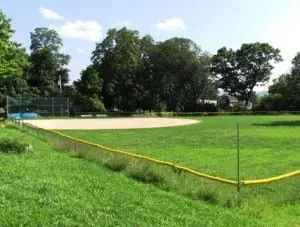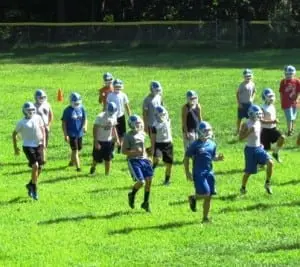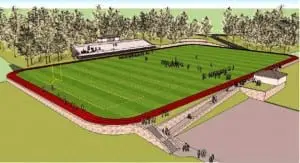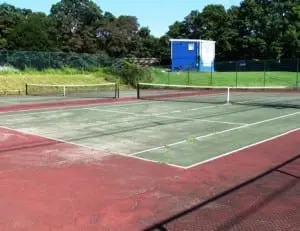
9D field improvements will be first step
By Michael Turton
Trustees on the Haldane Board of Education are making good on their intention not to allow a recently completed report on improving athletic fields in Philipstown to gather dust on a shelf. At a special public meeting on Feb. 15 board members made it clear they will move forward on improvements to the softball fields on Route 9D and make badly needed repairs to the school’s tennis courts. The Board also asked Superintendent Mark Villanti to begin discussions with the New York State Department of Education (NYSED) regarding possible funding assistance for development of a much-improved facility on the current site of Haldane’s football field. In what came as a bit of a surprise, Villanti also said that recent discussions have raised the possibility of locating a regulation running track at St. Basil Academy.

Earlier this year, Ward and Associates, a consulting firm that specializes in athletic field design and improvement, put forward its recommendations [which can be viewed on the Haldane website] for upgrading all sports fields located in Philipstown as part of a study commissioned by Haldane Central School District, Town of Philipstown, Village of Cold Spring and Village of Nelsonville. Separate and distinct from the Ward report, Haldane had previously received a grant of $150,000 through the office of State Sen. Greg Ball for improvements to athletic facilities on campus. Officials at the school district waited until the Ward report was complete before deciding to focus the Ball grant on the 9D ball fields in order to ensure there were no conflicts with the report’s recommendations.
Improvements on 9D will include upgrading the upper playing field and establishing a practice field on the lower level, which can also be used as an interim Little League baseball field. Fencing, dugouts and parking will also be improved. The badly cracked tennis courts will be re-sealed – an interim measure until a plan for what will likely be at least three new courts is determined.

The Ward report recommended that Haldane be the site of the community’s main “game field” and trustees and administration are taking that to heart. Recommendations include significant improvements to the current football field – incorporating either a new turf or synthetic playing surface. Also included is a non-regulation running track which would ring the field and include stations for some field events. Grandstands, press booth and concessions would be moved to the east side of the field. Based on comments to date there seems to be more interest in installing a synthetic playing surface. A major benefit of that would the ability to use the synthetic field on a daily basis, including for physical education classes for primary grade students who currently can’t have classes outdoors. Depending on project details, such an undertaking could cost $2 million and closer to $3 million if night lighting is included.

While all trustees expressed support for exploring funding possibilities with the state, Trustee Peter Henderson said that while he supports Villanti’ s fact finding mission and recognizes the sports fields are not adequate, “I have huge concerns around the costs.” He also said he wanted to see budget figures addressing the impact of such a project over a three to five-year period. “I don’t want to [issue a] bond for athletics while cutting academic programs,” he said.
Villanti said that any funding from the state, generally at the 33 percent level for projects of this nature, would have to include improvements to the interior of the schools. When Henderson asked if that meant that a $3 million sports facility project might bring with it $1 million worth of interior improvements, which in essence would be “free” thanks to state funding, Villanti replied, “It’s very possible,” adding that such a scenario had taken place in Chappaqua.
When School Board President Joe Curto said that there may be a need to establish a fundraising group to raise “some real money” from the private sector, Philipstown Town Board member Nancy Montgomery, who was in the audience, questioned that strategy – if it involved creating a new fundraising group. “The Town already has a mechanism set up to do fundraising. Won’t that be spinning our wheels? It could take a year to set up another group,” she said. Curto responded that the Haldane group could be a subsidiary of the existing organization – Friends of Philipstown Recreation.
Trustee Michael Junjulas said that the entire process needs to be thought through thoroughly – including the potential value and uses for the James Pond portion of the campus, east of the school. The school district has contracted Badey and Watson to survey and appraise the roughly 10-acre property. He also said that school district’s funds must stay within the district. “Our hands are tied a lot more than Philipstown’s.”
Montgomery wondered whether the cooperation fostered by participation in the Ward report was being lost. “I’m getting skeptical,” she said. “Can’t all the groups work together – consolidate?” she asked. “The committee (including the Town, both Villages and other stakeholders) will meet on March 7,” Curto said. “Part of moving forward is to continue talking but also look at finances. What we don’t want [re: the Ward report] is to say, ‘This is nice…let’s look at it next year.’ The [full] committee can help keep the vision consistent while moving forward. I’m optimistic. It can happen.”
 Track at St. Basil?
Track at St. Basil?
Villanti said he had recently discussed the issue of a regulation running track with officials at St. Basil Academy in Garrison. That site was identified in the Ward report as the best location for such a facility. Villanti said that the area surrounding the soccer field at St Basil had actually been engineered to accommodate a track in the 1980s. “St. Basil has interest in building a track for [use by] the Town and Haldane,” he said. “If their interest wasn’t serious I wouldn’t raise it today.” He also said there would be some “quid pro quo” involved. “[The Town of] Philipstown would have to be part of the discussion. I won’t speak for the Town – there is some possibility [of a track] at Philipstown Park as well.” The Haldane football field site is not large enough to accommodate a regulation track.


Just to expand on my comments about fundraising. The Ad Hoc Committee met last on 2/8 & discussed the need for a coordinated fundraising strategy if the plan is to be executed. Given the practical complications of having many different legal entities owning different parcels and operating under various laws as well as there being multiple not for profit entities associated with each of same ( ex: FOPR, Blue Devil Booster Club,etc…) and each having their own mission statements we agreed to discuss this further on 3/7 ( 7:30am Town Hall). There are many successful models out there which have been done & we agreed to look at those in starting a process. I “highly” encourage anyone who is pro/con/indifferent to read thru the meeting minutes of the Ad Hoc Committee, their posted at http://www.philipstownrecreation.com click ” community”. 35 minutes will get you thru the past 13 months of conversations and tell a good story of mutual cooperation.
Thanks for the great story! One of the items also discussed at the meeting was the proposed arrangement for parking at the 9D ball field. At present, this is chaotic and dangerous, nose-in parking directly off 9D, with cars and vans backing up into the fast 9D traffic, children, and pets. The Consultants propose that the nose-in parking be retained, but that the cars park diagonally to reduce how far they have to back up into 9D.
This is an inadequate solution. When I asked whether any alternatives had been evaluated, I was told that the “ideal solution” would be to have a concrete barrier island or walk between 9D and the parking area, but that there was not enough room for it.
I asked for the specific details of the analysis that rejected the ideal plan. That probably sounds like nitpicking, but there are very good reasons for asking the question.
The width of the parking area for the ideal plan actually would vary depending on the configuration of the parking in the lot. Vertical, 90 degree parking need more space than diagonal, and you can angle the parking more or less acutely to change the width. Finally, you can parallel park, which would require the least width of all.
I would bet that one or more variations will work in the available space. The real trade off is the number of spaces (there would be fewer with parallel parking inside the reconfigured lot), and safety, versus maximizing the number of cars that can crowd in.
Sure, we need a few spaces for handicapped-restricted parking, and we need some spaces to allow unloading of sports equipment. But given that there is already so much parking nearby, do we really want to sacrifice safety for a few extra spaces?
The just adopted Comprehensive Plan in Cold Spring specifically calls for the parking in the 9D ball field to be improved by establishing a one way in and one way out flow and a sidewalk “island”. Remember that many pedestrians and hikers walk along Morris Avenue to the trail heads of 9D. This section is extremely hazardous, and the proposal barely improves it at all. Unless the Consultants can show exactly why no “ideal” parking plan will work, including parallel parking, and not just say “it won’t fit” without telling us what it is won’t fit, the safest design should be selected.
Mike Armstrong